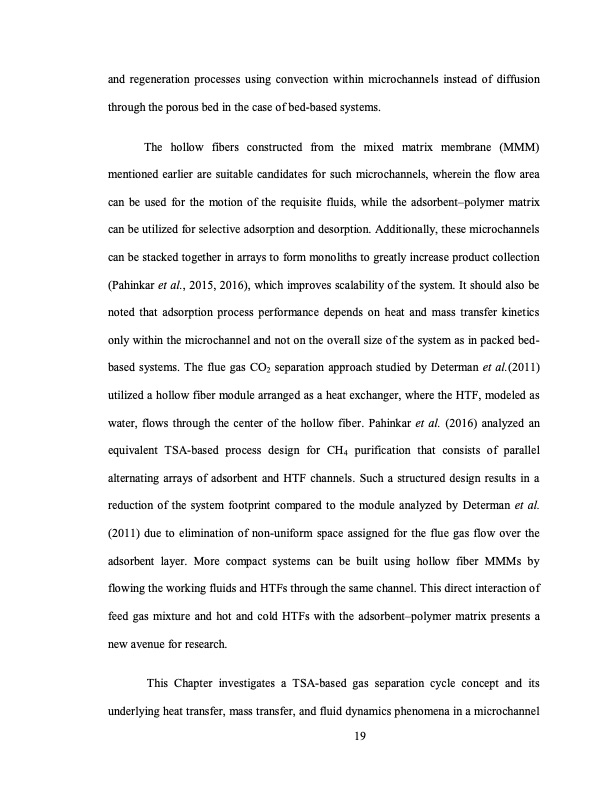
PDF Publication Title:
Text from PDF Page: 046
and regeneration processes using convection within microchannels instead of diffusion through the porous bed in the case of bed-based systems. The hollow fibers constructed from the mixed matrix membrane (MMM) mentioned earlier are suitable candidates for such microchannels, wherein the flow area can be used for the motion of the requisite fluids, while the adsorbent–polymer matrix can be utilized for selective adsorption and desorption. Additionally, these microchannels can be stacked together in arrays to form monoliths to greatly increase product collection (Pahinkar et al., 2015, 2016), which improves scalability of the system. It should also be noted that adsorption process performance depends on heat and mass transfer kinetics only within the microchannel and not on the overall size of the system as in packed bed- based systems. The flue gas CO2 separation approach studied by Determan et al.(2011) utilized a hollow fiber module arranged as a heat exchanger, where the HTF, modeled as water, flows through the center of the hollow fiber. Pahinkar et al. (2016) analyzed an equivalent TSA-based process design for CH4 purification that consists of parallel alternating arrays of adsorbent and HTF channels. Such a structured design results in a reduction of the system footprint compared to the module analyzed by Determan et al. (2011) due to elimination of non-uniform space assigned for the flue gas flow over the adsorbent layer. More compact systems can be built using hollow fiber MMMs by flowing the working fluids and HTFs through the same channel. This direct interaction of feed gas mixture and hot and cold HTFs with the adsorbent–polymer matrix presents a new avenue for research. This Chapter investigates a TSA-based gas separation cycle concept and its underlying heat transfer, mass transfer, and fluid dynamics phenomena in a microchannel 19PDF Image | TEMPERATURE SWING ADSORPTION PROCESSES FOR GAS SEPARATION

PDF Search Title:
TEMPERATURE SWING ADSORPTION PROCESSES FOR GAS SEPARATIONOriginal File Name Searched:
PAHINKAR-DISSERTATION-2016.pdfDIY PDF Search: Google It | Yahoo | Bing
CO2 Organic Rankine Cycle Experimenter Platform The supercritical CO2 phase change system is both a heat pump and organic rankine cycle which can be used for those purposes and as a supercritical extractor for advanced subcritical and supercritical extraction technology. Uses include producing nanoparticles, precious metal CO2 extraction, lithium battery recycling, and other applications... More Info
Heat Pumps CO2 ORC Heat Pump System Platform More Info
| CONTACT TEL: 608-238-6001 Email: greg@infinityturbine.com | RSS | AMP |